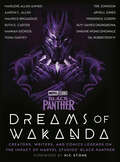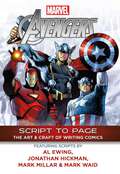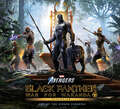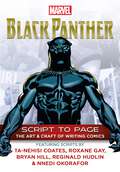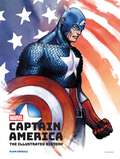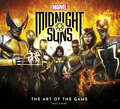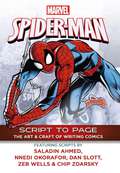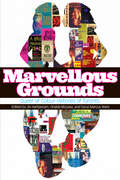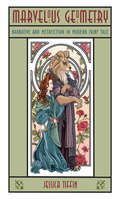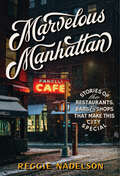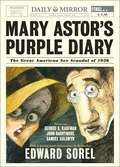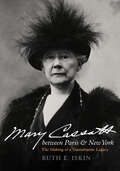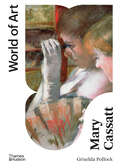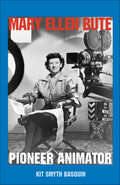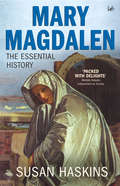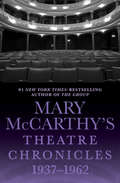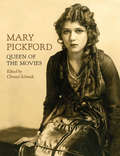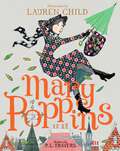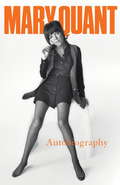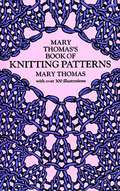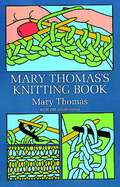- Table View
- List View
Marvel Studios' Black Panther: Creators, Writers, and Comics Legends on the Impact of Marvel Studios' Black Panther
by Maurice Broaddus Marvel Frederick Joseph Suyi Davies Okungbowa Yona Harvey Ruth E. Carter Hannah Giorgis Tre Johnson Marlene Allen Ahmed Aaron C. Allen Arvell Jones Dwayne Wong Omowale Gil Robertson Mateus ManhaniniJoin creators, writers, and comics legends as they discuss the impact of Marvel Studios&’ Black Panther in this gorgeously illustrated collection of essays Marvel Studios&’ Black Panther has become more than just a movie—it has shaped conversations about art, culture, science fiction, representation, justice, fashion, comics, creativity, and so much more. Celebrate the legacy of the film with this collection of all-new personal essays and reflections that shed light on its monumental impact, including firsthand stories from artists involved in the film, cultural analysis from journalists and academics, and thoughtful insights from writers and comics legends. Each contributor brings their unique expertise and experience to explore the film&’s genesis and significance from every angle. Complete with gorgeous original illustrations, Dreams of Wakanda brings together a wide array of diverse and multifaceted perspectives that exemplify the many ways the film has impacted cinema, culture, and society. In this collection:• Costume designer Ruth E. Carter takes us through her Afrofuturistic designs.• Writer Tre Johnson discusses the metaphoric qualities of vibranium.• Author Yona Harvey reflects on how the film has resonated with audiences across the African diaspora.• Journalist Hannah Giorgis uncovers how the soundtrack fits into sonic portraits of Blackness. The contributors:Marlene Allen Ahmed • Aaron C. Allen • Maurice Broaddus • Ruth E. Carter • Hannah Giorgis • Yona Harvey • Tre Johnson • Arvell Jones • Frederick Joseph • Suyi Davies Okungbowa • Dwayne Wong Omowale • Gil Robertson IV • Foreword by Nic Stone • Art by Mateus Manhanini To celebrate the launch of this book and Black Panther&’s global impact, Disney and Penguin Random House are donating books to First Book and Books for Africa respectively. Disney is donating books valued at approximately $1,000,000 to support First Book, a leading nonprofit that serves children in underserved communities and addresses the needs of the whole child by supporting their education, basic needs, and wellness—all of which are essential to educational equity. Penguin Random House (PRH) is donating PRH titles valued at approximately $100,000 to Books For Africa. Books For Africa was founded upon a singular mission: to end the book famine in Africa. BFA collects, sorts, and ships books, computers, tablets, and library enhancement materials to every country in Africa.
Marvel's Avengers - Script To Page
by Al Ewing, Jonathan Hickman, Mark Millar & Mark WaidDiscover the craft of writing comics the Marvel way, with scripts and commentary from top writers and editors.The Marvel Script To Page series is an official behind-the-scenes look at the craft of writing comic books, featuring exclusive scripts and commentary from top Marvel creators and editors. The Avengers are the Earth&’s mightiest heroes, and one of the most famous superhero teams in comics history Meet Captain America, Iron Man, Black Widow and many, many more iconic characters in selected scripts from a range of contemporary comics creators, with exclusive editorial commentary.
Marvel's Avengers: Black Panther: War for Wakanda Expansion: Art of the Hidden Kingdom
by Matthew PellettThe official art book for the Marvel&’s Avengers expansion Black Panther: War for WakandaBlindsided by a betrayal and the resulting tragedy, King T&’Challa, the Black Panther, devoted protector and current ruler of Wakanda finds it difficult to entrust his duty to anyone else, even his sister Shuri, while also confronting those who wish to do Wakanda harm. When arch-villain Klaw&’s forces threaten Wakanda&’s safety, T&’Challa must take the fight right to them to defend everything and everyone he holds dear. Players experience the game&’s story and additional missions in the ongoing Avengers Initiative in the lush jungles of Wakanda, an entirely new environment and sole location of the world&’s Vibranium. They also get to explore the Royal Palace that overlooks Birnin Zana, known as &“The Golden City,&” in a new Outpost that contains Shuri&’s laboratory, Zawavari&’s chambers, and the Wakandan War Room. Unmask the artistry behind the expansion in this showpiece hardback book containing exclusive concept sketches, character art, storyboards, and fully rendered scenes alongside fascinating insights into the creative process from the talented creators of the expansion.
Marvel's Black Panther - Script To Page
by MarvelDiscover the craft of writing comics the Marvel way, with scripts and commentary from top writers and editors.The Marvel Script To Page series is an official behind-the-scenes look at the craft of writing comic books, featuring exclusive scripts and commentary from top Marvel creators and editors. Explore the world of Wakanda and its mighty champion and protector, the Black Panther. Meet T&’challa, Shuri, the Dora Milaje and many, many more iconic characters in selected scripts from a range of contemporary comics creators, with exclusive editorial commentary.
Marvel's Captain America: The Making of the Star-Spangled Avenger
by Insight Editions Alan CowsillExperience the complete comic book history of the iconic super hero, Captain America, with this comprehensive visual guide including full-color illustrations, concept art, and more! Featuring interviews with key artists and writers essential to the creation and evolution of the Star-Spangled Avenger!Chronicling eight decades of the art of the Sentinel of Liberty, Marvel's Captain America: The Illustrated History dives into the creation of the character in 1940 and his journey to becoming one of the most popular and recognizable Marvel characters of all time. Alongside exclusive interviews with the artists and minds that brought the character to life, the book is filled with stunning imagery and behind-the-scenes illustrations. Featuring iconic cover art and full-color panels, this is the complete exploration of the quintessential American Super hero—from Steve Rogers to Sam Wilson, and a celebration of heroes Cap inspired like Captain Carter and Iron Patriot. Marvel's Captain America: The Illustrated History is the perfect addition to any comic lover's collection.
Marvel's Midnight Suns - The Art of the Game
by Paul DaviesOfficial art book of the Marvel's Midnight Suns video game, packed with interviews with the creative team behind the game, as well as stunning concept art created during the development process.When the demonic Lilith and her fearsome horde unite with the evil armies of Hydra, it&’s time to unleash Marvel&’s dark side. As The Hunter, your mission is to lead an unlikely team of seasoned Super Heroes and dangerous supernatural warriors to victory. Can legends such as Doctor Strange, Iron Man, and Blade put aside their differences in the face of a growing apocalyptic threat? If you&’re going to save the world, you&’ll have to forge alliances and lead the team into battle as the legendary Midnight Suns—Earth&’s last line of defence against the underworld.Marvel&’s Midnight Suns – The Art of the Game captures the creative process of this much-anticipated game. The exclusive concept art and in-game renderings created by the talented development team—creating the game in collaboration with Marvel—are shown in glorious detail in this lush, hardback volume. Characters, locations, gadgets, weapons, monsters, enemies, and much more are all accompanied by unique insights from the artists and developers behind the game. So step into the world of Marvel&’s Midnight Suns – and rise up against the darkness!
Marvel's Spider-Man - Script To Page
by MarvelDiscover the craft of writing comics the Marvel way, with scripts and commentary from top writers and editors.The Marvel Script To Page series is an official behind-the-scenes look at the craft of writing comic books, featuring exclusive scripts and commentary from top Marvel creators and editors. It&’s been 60 years since the spectacular Spider-Man first swung into action, and the web-slinging superhero is now a household name. Meet Peter Parker, Miles Morales, Doctor Octopus and many, many more iconic characters in selected scripts from a range of contemporary comics creators, with exclusive editorial commentary.
Marvellous Grounds: Queer of Colour Histories of Toronto
by Jin Haritaworn, Ghaida Moussa, and Syrus Marcus WareToronto has long been a place that people of colour move to in order to join queer of colour communities. Yet the city’s rich history of activism by queer and trans people who are Black, Indigenous, or of colour (QTBIPOC) remains largely unwritten and unarchived. While QTBIPOC have a long and visible presence in the city, they always appear as newcomers in queer urban maps and archives in which white queers appear as the only historical subjects imaginable. The first collection of its kind to feature the art, activism, and writings of QTBIPOC in Toronto, Marvellous Grounds tells the stories that have shaped Toronto’s landscape but are frequently forgotten or erased. Responding to an unmistakable desire in QTBIPOC communities for history and lineage, this rich volume allows us to imagine new ancestors and new futures.
Marvelous Geometry: Narrative and Metafiction in Modern Fairy Tale
by Jessica TiffinExplores self-consciousness and metafictional awareness in modern fairy tale and its expression across literary fairy tale, popular fairy tale, and fairy-tale film.
Marvelous Manhattan: Stories of the Restaurants, Bars, and Shops That Make This City Special
by Reggie Nadelson&“A wonderfully lively, knowledgeable journey through the past and present of places that help make New York City what it is, and which we must cherish and (hopefully) preserve.&” —Salman Rushdie New York might have Broadway, Times Square, and the Empire State Building, but the real heart and soul of the city can be found in the iconic places that have defined cool since &“cool&” became a word. Places like Di Palo&’s in Little Italy, where you might stop in to pick up a little cheese only to find yourself in a long conversation—part friendly chat, part profound tutorial—with fourth-generation owner Lou Di Palo, sampling cheeses all the while. Or Raoul&’s in SoHo, to enjoy a classic steak-frites in the company of downtown artists, celebrities, and dyed-in-the-wool locals. Or Minton&’s Playhouse in Harlem, to be in the room where some young guys named Thelonious, Dizzy, and Charlie invented bebop. Or maybe Russ & Daughters, to pick up the city&’s best lox and bagels, which they&’ve been selling since 1914. A lifelong New Yorker, writer Reggie Nadelson celebrates her city and all the places that make it special. Part guidebook, part cultural history, part walk down memory lane, alive with the spirit and the grit of small, often family-owned businesses that have survived the Great Depression, World War II, 9/11, and the coronavirus lockdown, Marvelous Manhattan is a seductive and timely book for anyone who lives in New York, loves the city, lived there once, or wishes they had. Because that&’s the thing about Manhattan: all you need to do is walk into the right place—say, Fanelli&’s on Prince Street—sit down at the bar, order a drink, open this book, and suddenly you&’re a New Yorker.
Marxism Beyond Marxism
by Rebecca E. Karl Saree Makdisi Cesare CasarinoThese essays critically rethink Marxism in the light of the disintegration of communist regimes Eastern Europe and the Soviet Union. Containing essays from a group of internationally distinguished writers and intellectuals, this collection addresses Marxism as a cultural-political problematic. Contending that Marxism is deeply embedded in specific cultural practices, the contributors illuminate Marxism's contribution to discussions of labour in post-industrial capitalism, to controversies surrounding compulsory heterosexuality and queer theory, and to debates about the institutionalization and academicization of the "New" Left. In examining Marxism's relationship to cultural practices, the contributors make a case for Marxism's continued relevance. By combining a diversity of perspectives, these essays demonstrate that Marxism addresses urgent needs that are often forsaken by other political and ideological practices. They show how - now more than ever - Marxism's reaffirmation can serve as a sophisticated and cunning response to the latest global developments - and travesties.
Marxism and 20th-Century English-Canadian Novels
by John Z. Ming Chen Yuhua JiThis monograph is the first academic work to apply a neo-Marxist approach to 20th-century Canadian social realist novels, pursuing a refreshingly (neo-)Marxist approach to such issues as Bakhtinian notions of the novelistic form and dialogism as applied to Canadian socio-political novels influenced by various socialisms, socialist-feminist concerns, economic and sexual politics, and the genre of social realism. In so doing, it demonstrates that Marxist socialism is as relevant today as it was in the 1930s, just as social realist novels continue to thrive as a critique of capitalism. Readers will find valuable insights into the social significance, formal innovations, moral sensitivity, aesthetic enrichment, and ideological complexity of Canadian social realist novels.
Mary Astor's Purple Diary: The Great American Sex Scandal of 1936
by Edward SorelIn a hilarious send-up of sex, scandal, and the Golden Age of Hollywood, legendary cartoonist Edward Sorel brings us a story (literally) ripped from the headlines of a bygone era. In 1965, a young, up-and-coming illustrator by the name of Edward Sorel was living in a $97-a-month railroad flat on Manhattan's Upper East Side. Resolved to fix up the place, Sorel began pulling up the linoleum on his kitchen floor, tearing away layer after layer until he discovered a hidden treasure: issues of the New York Daily News and Daily Mirror from 1936, each ablaze with a scandalous child custody trial taking place in Hollywood and starring the actress Mary Astor. Sorel forgot about his kitchen and lost himself in the story that had pushed Hitler and Franco off the front pages. At the time of the trial, Mary Astor was still only a supporting player in movies, but enough of a star to make headlines when it came out that George S. Kaufman, then the most successful playwright on Broadway and a married man to boot, had been her lover. The scandal revolved around Mary's diary, which her ex-husband, Dr. Franklyn Thorpe, had found when they were still together. Its incriminating contents had forced Mary to give up custody of their daughter in order to obtain a divorce. By 1936 she had decided to challenge the arrangement, even though Thorpe planned to use the diary to prove she was an unfit mother. Mary, he claimed, had not only kept a tally of all her extramarital affairs but graded them--and he'd already alerted the press. Enraptured by this sensational case and the actress at the heart of it, Sorel began a life-long obsession that now reaches its apex. Featuring over sixty original illustrations, Mary Astor's Purple Diary narrates and illustrates the travails of the Oscar-winning actress alongside Sorel's own personal story of discovering an unlikely muse. Throughout, we get his wry take on all the juicy details of this particular slice of Hollywood Babylon, including Mary's life as a child star--her career in silent films began at age fourteen--presided over by her tyrannical father, Otto, who "managed" her full-time and treated his daughter like an ATM machine. Sorel also animates her teenage love affair with probably the biggest star of the silent era, the much older John Barrymore, who seduced her on the set of a movie and convinced her parents to allow her to be alone with him for private "acting lessons." Sorel imbues Mary Astor's life with the kind of wit and eye for character that his art is famous for, but here he also emerges as a writer, creating a compassionate character study of Astor, a woman who ultimately achieved a life of independence after spending so much of it bullied by others. Featuring ribald and rapturous art throughout, Mary Astor's Purple Diary is a passion project that becomes the masterpiece of one of America's greatest illustrators.
Mary Blair's Unique Flair: The Girl Who Became One of the Disney Legends
by Amy Novesky40-page storybook based on the colorful and inspiring life of Mary Blair, the creative mind behind It's a "Small World", and concept artist for "Cinderella", "Peter Pan", "Alice in Wonderland"
Mary Cassatt between Paris and New York: The Making of a Transatlantic Legacy
by Ruth E. IskinThe first comprehensive study of Cassatt’s life, work, and legacy through the prism of a transatlantic framework. This book re-envisions Mary Cassatt in the context of her transatlantic network, friendships, exhibitions, politics, and legacy. Rather than defining her as either an American artist or a French impressionist, author Ruth E. Iskin argues that we can best understand Cassatt through the complexity of her multiple identifications as an American patriot, a committed French impressionist, and a suffragist. Contextualizing Cassatt’s feminist outlook within the intense pro- and anti-suffrage debates in the United States, Iskin shows how these impacted her artistic representations of motherhood, fatherhood, and older women. Mary Cassatt between Paris and New York also argues for the historical importance of her work as an advisor to American collectors, and demonstrates the role of museums in shaping her legacy, highlighting the combined impact of gender, national, and transnational dynamics.
Mary Cassatt: Painter of Modern Women (World of Art)
by Griselda PollockThis groundbreaking study, the definitive introduction to the work of artist Mary Cassatt, places her work in the wider context of nineteenth-century feminism and art theory and is now updated with color illustrations. This groundbreaking study redefines the status of the beloved American artist Mary Cassatt, placing her work in the wider context of nineteenth- century feminism and art theory. Mary Cassatt looks at the artist’s work in light of her time as an advocate for women’s intellectual life and political emancipation. Esteemed by her contemporaries for her commitment to what she and her radical colleagues in Paris termed "the new art"—now called impressionism—Cassatt brought her discerning gaze and compositional inventiveness to the study of the subtle, often psychological, social interactions of women in public and private spaces. Focusing on key moments of engagement and change over the artist’s long career, art historian Griselda Pollock discusses Cassatt’s artistic training across Europe, her profound study of the old masters, and places fresh emphasis on the artist’s interest in Manet and other contemporary French and Spanish painters as well as her influence on American collections of French modernism. Now revised with a new preface, updates to the bibliography, and color illustrations throughout, this book offers a reevaluation of the work of this important artist as seen through the frames of class, gender, space, and difference.
Mary Ellen Bute: Pioneer Animator
by Kit Smyth BasquinMary Ellen Bute: Pioneer Animator captures the personal and professional life of Mary Ellen Bute (1906–1983) one of the first American filmmakers to create abstract animated films in 1934, also one of the first Americans to use the electronic image of the oscilloscope in films starting in 1949, and the first filmmaker to interpret James Joyce's literature for the screen, Passages from James Joyce's Finnegans Wake, a live-action film for which she won a Cannes Film Festival Prize in 1965. Bute had an eye for talent and selected many creative people who would go on to be famous. She hired Norman McLaren to hand paint on film for the animation of her Spook Sport, 1939, before he left to head the animation department of the Canadian Film Board. She cast the now famous character actor Christopher Walken at age fourteen as the star of her short live-action film, The Boy Who Saw Through, 1958. Also, Bute enlisted Elliot Kaplan to compose the film score of her Finnegans Wake before he moved on to compose music for TV's Fantasy Island and Ironside. This biography drawn from interviews with Bute's family, friends, and colleagues, presents the personal and professional life of the filmmaker and her behind-the-scenes process of making animated and live action films.
Mary Magdalen: Truth and Myth
by Susan HaskinsA dramatic, thought-provoking portrait of one of the most compelling figures in early Christianity which explores two thousand years of history, art, and literature to provide a close-up look at Mary Magdalen and her significance in religious and cultural thought.
Mary McCarthy's Theatre Chronicles, 1937–1962: Mary Mccarthy's Theatre Chronicles, 1937-1962 And On The Contrary
by Mary McCarthyThe American theatre comes alive in Mary McCarthy&’s provocative anthology of essaysHer literary writings and dramatic criticism have appeared in the New Yorker and the New York Review of Books. Mary McCarthy&’s Theatre Chronicles gathers together a wide-ranging collection featuring a cast of playwrights, actors, and directors that reads like a &“who&’s who&” of American theatre. With chapters ranging from &“The Unimportance of Being Oscar&” to &“Odets Deplored,&” this lively and witty volume opens a revealing window onto every aspect of theatre. McCarthy brings singular productions of the world&’s most famous plays to vivid dramatic life while dissecting literary giants like Tennessee Williams and Arthur Miller. She offers her controversial opinion on everything from the American school of realism as epitomized by Brando to what creates a great actress to how a badly written play can still make for good theatre.With passages on theatre figures from Shakespeare to Shaw to Ibsen and O&’Neill, this is a must-have for theatre lovers and armchair critics everywhere.This ebook features an illustrated biography of Mary McCarthy including rare images from the author&’s estate.
Mary Pickford: Queen of the Movies
by Christel Schmidt&“Explains Pickford&’s roles as not only a talented actress, but also as a philanthropist and industry leader who managed to end up her own producer.&” —Time Out In the early days of cinema, when actors were unbilled and unmentioned in credits, audiences immediately noticed Mary Pickford. Moviegoers everywhere were riveted by her magnetic talent and appeal as she rose to become cinema&’s first great star. In this engaging collection, co-published with the Library of Congress, an eminent group of film historians sheds new light on this icon&’s incredible life and legacy. Pickford emerges from the pages in vivid detail, revealed as a gifted actress, a philanthropist, and a savvy industry leader who fought for creative control of her films and ultimately became her own producer. With extensive photos and illustrations, this book paints a fascinating portrait of a key figure in American cinematic history. Includes over 200 photos, illustrations, and stills from the collections of the Library of Congress and Academy of Motion Picture Arts and Sciences
Mary Poppins Gift Edition
by P. L. TraversA beautifully illustrated edition for new and lifelong fans of P. L. Travers's Mary Poppins from Lauren Child, creator of Charlie and Lola!Experience the fantastical adventures of the magical nanny who inspired the classic film, stage show, and young imaginations the world over in a whole new way. With charming illustrations in her signature collage style from Kate Greenaway Medal winner, Children's Laureate, MBE, and Smarties Gold Award winner Lauren Child, this edition is selectively abridged. Perfect for the lifelong Mary Poppins fan or serious collector, the Gift Edition makes for a lovely family read-aloud or first introduction to the unforgettable story!
Mary Quant: My Autobiography
by Mary QuantMary Quant defined the 60s as a renowned fashion designer and all-round style icon, most famous for inventing the miniskirt and hot pants. Not afraid of novelty or experimentation, she showed a generation of women how to dress to please themselves. Quant's career was fulsome and varied - from opening up a clothes shop on the King's Road called Bazaar, designing the interior of the Mini (including her signature daisy), to her vast cosmetics company, Mary Quant Limited, she has widespread appeal to generations of women. In her autobiography, Mary combines the inspirational story of a stellar career with the touching personal story of her life with the man she loved, Alexander Plunkett-Green and her role of mother to their son, Orlando. Mary Quant gives us a glimpse of the real women behind the icon.
Mary Quant: My Autobiography
by Mary QuantMary Quant defined the 60s as a renowned fashion designer and all-round style icon, most famous for inventing the miniskirt and hot pants. Not afraid of novelty or experimentation, she showed a generation of women how to dress to please themselves. Quant's career was fulsome and varied - from opening up a clothes shop on the King's Road called Bazaar, designing the interior of the Mini (including her signature daisy), to her vast cosmetics company, Mary Quant Limited, she has widespread appeal to generations of women. In her autobiography, Mary combines the inspirational story of a stellar career with the touching personal story of her life with the man she loved, Alexander Plunkett-Green and her role of mother to their son, Orlando. Mary Quant gives us a glimpse of the real women behind the icon.
Mary Thomas's Book of Knitting Patterns (Dover Knitting, Crochet, Tatting, Lace)
by Mary ThomasThis book contains the fruits of centuries of experience and invention in knitting and is quite possibly the best single manual of knitting patterns ever written. Turning its pages, you will see the patterns grow from simple to more elaborate. You will find this to be the best arrangement for instructional purposes as well as a demonstrations of the orderly and scientific methods on which knitting patterns are based. You will be astonished at the great beauty and variety of these patterns, and you will come to realize the potential of knitting, in practiced hands, as one of the finest of crafts.The author begins with basics, with the distinction between knit and purl sides of the fabric and the use of simple black-and-white charts to present patterns. She then introduces a new motif or design in each chapter. Charts, diagrams, and photographs are used liberally along with the text to illustrate each pattern and steps in the creation of each, with special symbols to indicate critical points, so that you can guard against going astray. The patterns range from cross and cross-over motifs through slip-stitch patterns, eyelet patterns, faggot and lace faggot stitch, bias fabrics, lace knitting, embossed motifs and patterns, medallion knitting, picot point knitting, and filet lace. Concluding chapters are devoted to seamless garments and accessories, modern garments, and ornamental uses of increasing and decreasing. There are lists of French and German knitting terms and an index of textures.Special attention is given throughout to explaining the how and why of each pattern, and the properties of each in terms of horizontal and vertical stretching so that selection of patterns can be made practically as well as aesthetically. The beginner will find this book an excellent guide and instruction manual, and the experienced knitter will find it an almost inexhaustible encyclopedia of patterns, methods, and suggestions.
Mary Thomas's Knitting Book
by Mary ThomasThere is a knitting book as dependable as your own private instructor, as complete, as explicit, and equally as helpful . . . Mary Thomas's Knitting Book. It's a veritable encyclopedia of knitting, clearly and definitively explaining and illustrating every method, operation and stitch, and a good number of the patterns you are ever likely to need or use. After an engaging history of the craft and its implements, Miss Thomas carefully lays the foundation of knitting in the opening chapters ― how to hold needles, wind yarn, gauge stitches, control tension, etc. ― and builds gradually upon it in the following sections. These explain in lucid progression every operation in common knitting, from basic knit stitch and purl, casting on and casting off, shaping by decreases and increases to turning, triangular shapes and mitres, and knitting on the diagonal or bias. For the reader who has mastered these fundamental procedures, Miss Thomas devotes the remainder of the book to fancy knitting stitches and techniques, including color knitting by stranding and weaving; pattern weaving; knitting woven, by frame with its complement of stitches (plain, raised, rib, etc.), looped, beaded, embroidered by chart, using cross stitch, honeycomb, etc.; and making patterns for garments and working out their details (armholes, belts, buttonholes, collars, hems, necklines, pockets et al). To put what the reader learns into practice, she offers instructions and patterns for making various Shetland shawls, gloves, and socks. More than 250 technique diagrams clearly illustrate every operation and pattern as to position of hands, yarn, and needle, so the knitter will have no trouble in following along. For all knitters, whether beginner or adept, a chapter of helpful knitting hints on blocking, picking up dropped stitches, lengthening, knitting up, mending, taking-back (correcting), etc. completes these invaluable and personalized lessons.Unabridged republication of original (1938) edition.
